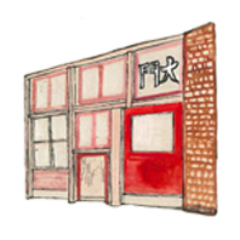Fred Wah, poet, project artist:
Our title “Playing Chinese,” suggests the complexities of mimesis at the vortex of diaspora and globalism. Here is an opportunity to scrutinize the reflective nature of “playing” with dreams: is the gold of “Gold Mountain” perhaps shifting back to Asia? And, beyond a Chinook jargon, what accoutrements of hybridity have we recuperated from the contact zone? As artists, how can we offer some mediation between history and what has become an increasingly “mixed up” world?
Nicola Harwood, curator and project artist:
High Muck a Muck: Playing Chinese plays with the notion of fakery, of imitation, of wearing the master’s clothes; of a reversal of roles as white Canada now strives to serve a Chinese economic master. It expresses some of the internal community struggles that erupt between different generations and classes of immigrants and it challenges the racist paradigm of an all white Canada into which Asian immigrants enter but are never fully allowed to arrive. The project deconstructs form by using a low-tech aesthetic within the gleam of the digital world and deconstructs subject matter by questioning the myth of immigration as a pathway to increased fortune and happiness. The journey may take you nowhere, the winnings of the game may be bitter. Home becomes forever dispersed. The Pacific ocean is the real boss.
Context / History of Project
Nicola Harwood, curator and project artist:
I conceived this project in 2010 partly in response to my work as the playwright of Salmon Row, a site-specific work that expressed the diverse and conflictual histories of the salmon industry on the Fraser River south of Vancouver. This work aroused my curiousity about the invisibility of Nelson, BC’s historic Chinatown. At the time I was director if Oxygen Art Centre in Nelson and interested in making projects responding to place.
My vision for the project was a multi-disciplinary collaboration where the artists would respond to the subject matter by collaboratively conceiving the form and content. I had known Fred for years and decided his text would be a strong fulcrum for the project – he was from Nelson and his work would bring an experimental aesthetic to the historical narrative. Jin Zhang has a background in both classical and new music with a strong grounding in both Western and Asian traditions – he was capable of bridging east and west; the historical with the contemporary. The performer / design team of Thomas Loh, Bessie Wapp and myself bring backgrounds working as performers, designers and directors in theatre, dance and site-specific environments. I knew this team would be willing to engage with unfamiliar territory and be able to apply a depth of innovative, cross-discipline experiences.
In our first collaborative workshop in October 2011, we were challenged with finding a common language across not only the languages of our disciplines – but also our spoken languages – Jin speaks English as a second language – as does Thomas. We were also faced with cracking the code of local vs global – how can the small stories of Nelson move beyond the cliché immigrant narrative – how can they relate to contemporary Canada, to contemporary China? Are we beholden to our rural community and their expectations? What is the content? What is the organizing metaphor, what is the form? After a week of intense discussion, research and community engagement, the team landed upon the organizing metaphor of gambling – fortunes told, fortunes made and fortunes lost.
The artists all felt strongly that the project needed to get beyond Nelson, while we simultaneously considered how to honour our location and present an accessible work to our local, rural audience. Eventually we decided that the project would manifest both digitally and as a live event, providing audiences with two main points of interaction: on-line from anywhere in the world, and through a community gathering at a gallery exhibition.
Over almost four years of development, the project has manifested as a series of short, poetic videos using text, sound, live action and puppets, an interactive website (which contains the videos as well as much other content) and a gallery installation. Other artists, designers and community members have come on board and contributed significantly to the final project.
Future plans for High Muck a Muck: Playing Chinese include a full translation of the website into Mandarin and Cantonese, a hardcopy catalogue / book project and further exhibitions of the installation.
